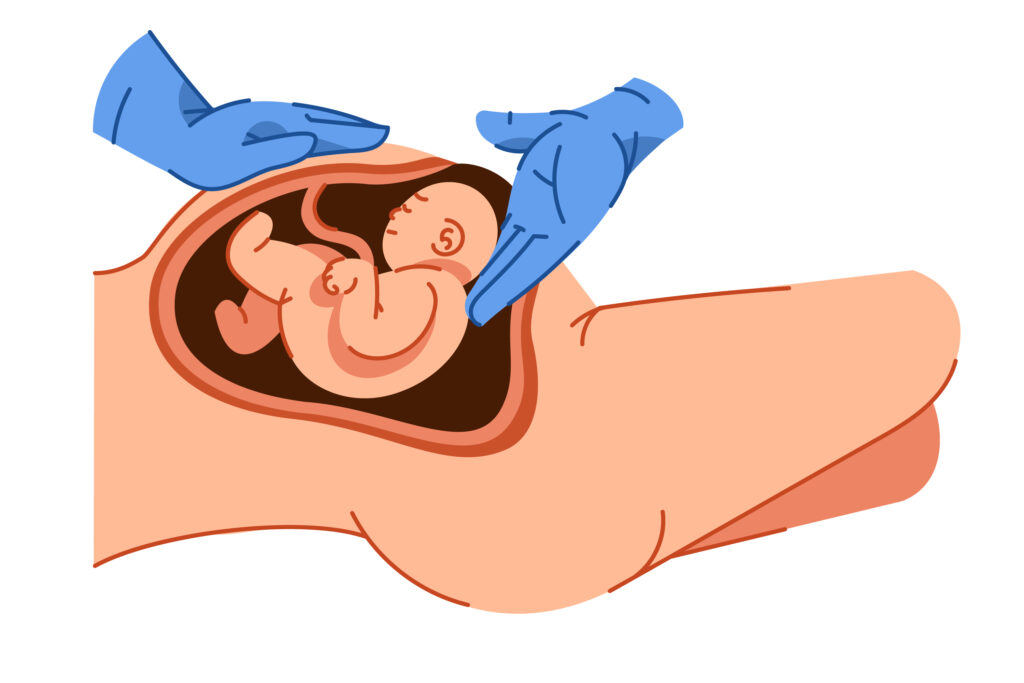
A C-section delivery, also known as a cesarean delivery, is a surgical procedure that involves the delivery of a baby through an incision in the mother’s abdomen and uterus. This procedure may be recommended for various reasons, including fetal distress, breech presentation, multiple pregnancies, or previous C-section deliveries.
The procedure is typically performed when a vaginal delivery may put the mother or baby at risk.
Why is C-section Done?
- Prolonged labor
- Fetal distress (low oxygen levels in the fetus)
- Umbilical cord compression
- Breech position of the baby (when baby is not head down)
- Transverse lie (baby lying horizontally or sideways)
- Placenta previa (placenta is attached too low in the uterus blocking the baby’s exit)
- Multiple pregnancies
- Health conditions
How to Prepare for a C-section?
- Talk to your doctor about your medical conditions to reduce the risk of anesthesia complications.
- You may need to undergo specific blood tests to know your blood type. This will help you in case you need a blood transfusion.
- You will have heart and blood pressure monitors applied.
- You need to stop eating or drinking for a few hours before the surgery.
Discuss any concerns with your doctor to ensure a safe and smooth delivery.
What to Expect During C-section?
- You will receive anesthesia to numb the lower half of her body during the surgery.
- A surgical incision will be made in the abdomen and uterus, and the baby will be delivered.
- The entire procedure usually takes about an hour, but the actual delivery time may vary.
After C-section: When to Call a Doctor?
- Breast pain accompanied by a fever
- Foul-smelling vaginal discharge
- Bleeding with large clots
- Pain when urinating
- Signs of infection (fever over 100 F, redness, swelling, or discharge from the incision)
C-section Recovery
- Allow yourself plenty of rest during the first few weeks after a cesarean delivery to give your body time to heal.
- Avoid heavy lifting and strenuous activities for several weeks after the surgery.
- Take any prescribed pain medication as needed to help manage any discomfort following your cesarean delivery.
- Use good posture to support your weakened abdominal muscles and reduce pain.
- Drink plenty of fluids to replace those lost during your cesarean delivery
- Avoid sexual activity for 4-6 weeks to allow your body to heal and minimize the risk of infection.
Best Week For Cesarean Delivery
The timing of a cesarean delivery depends on various factors, including the health of the mother and the baby, the reason for the C-section, and the advice of the obstetrician. In some cases, an emergency C-section may need to be performed immediately, while in other cases, a planned C-section may be scheduled before the due date.
If a planned C-section is recommended, the timing will usually be determined based on the gestational age of the baby and any underlying health conditions. In general, the best week for a planned C-section is typically between 39 and 40 weeks of pregnancy, but this may vary based on individual circumstances.
It is important to discuss the timing of a C-section with your doctor and to follow their recommendations for the safest and healthiest delivery for you and your baby.
Myth and Fact: C-section
Myth: C-sections are always riskier than vaginal deliveries.
Fact: C-sections have a slightly higher risk of complications than vaginal deliveries, but they are generally safe when performed by trained healthcare providers.
FAQs: C-section
Q: Is a C-section painful?
A: The mother will receive anesthesia during the surgery to numb the lower half of her body and pain medication will be prescribed after the surgery to manage any pain or discomfort.
Q: How long does it take to recover from a C-section?
A: It may take a few weeks to fully recover from a C-section, but recovery time varies depending on the individual circumstances.
Q. Is back pain common after c-section delivery?
Back pain can be common after a C-section, but it is not always directly related to the procedure itself. During a C-section, anesthesia is administered to numb the lower part of the body, which can cause muscles to relax and put strain on the lower back. Additionally, during the recovery period, women may adopt a hunched posture to protect the incision site, which can also contribute to back pain.
Conclusion: C-section delivery can be a safe and necessary option for delivering a baby in certain situations. It is important to discuss the risks and benefits of this procedure with your doctor and to prepare for the recovery period. Remember to take it easy, follow your doctor’s instructions, and reach out for support if needed. With proper care and attention, a successful and healthy recovery is possible after a C-section delivery.


